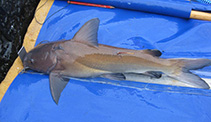| Family: |
Ariidae (Sea catfishes), subfamily: Galeichthyinae |
| Max. size: |
50 cm SL (male/unsexed) |
| Environment: |
benthopelagic; marine |
| Distribution: |
Indian Ocean: South Africa, |
| Diagnosis: |
Anal soft rays: 19-20; Vertebrae: 55-57. This species is distinguished by the following characters: total vertebrae 55-57 (19-21 precaudal, 36 caudal) and 15 pleural ribs attached to parapophyses of vertebrae 6 through 20; pectoral fin rays I, 12-13; anal fin rays 19-20; small and ovate eyes, dorsolaterally placed; vomerine tooth patches slightly separated at midline, continuous with lateral patches that taper at edges; premaxilla plates with pointed anterolateral corners; gill-rakers on anterior face of first arch 12-13; anterior dorsomedian cranial fontanelle constricted midway, approximating elongate hourglass-shape, with remnant posterior fontanelle relatively large; dorsal fin spine approximately two-thirds length of dorsal fin height (= longest dorsal ray); pectoral fin spine extending slightly beyond dorsal fin base at vertical, the humeral process of cleithrum with second, smaller blunt process on border between blade and prong; moderately large adipose fin, with free posterior rim about half into length of adipose-fin base, and darker in colour than upper body; fourth neural spine with thin anterior laminar keel and moderately elevated forward ridge extending to third neural spine, the Müllerian ramus of fourth vertebra with acute transverse edge on ventral side; pterotic with diminutive antrorse, pterotic spine; lateral line with short, oblique venules emanating both upward and downward along its length; heart-shaped swimbladder with anterior margins rounded, the longitudinal septum of the posterior chamber traversed by one small septum; dorsal and lateral body colour (in life and alcohol) medium brown to deep brown, the underside paler or yellowish, belly pigmented by fine brown specks posterior to isthmus only; fins blackish; barbels brown (Ref. 85159). |
| Biology: |
inhabits the relatively warm, shallow coastal waters of the east coast of South Africa, and is not known to enter estuaries. Reported to likely to utilize both rocky reef and soft substratum environments and is probably inactive by day, remaining in caves and other forms of refuge offered by reefs. Reported to feed on small fish and crabs and preyed on by a large variety of sharks. Gut contents in several prepared specimens (for osteological study) contained substantial amounts of crustaceans (prawn and crab) as well as small fish. Two females (43.5 and 45.0 cm SL) had more than 50 ripe eggs in each ovary, measuring up to approximately 1.7 cm in diameter. Reported to at least to 57 cm (questionably in TL) and 58 cm FL, from a survey of shore anglers (Ref. 85159). |
| IUCN Red List Status: |
Not Evaluated (N.E.) Ref. (130435)
|
| Threat to humans: |
harmless |
Source and more info: www.fishbase.org. For personal, classroom, and other internal use only. Not for publication.

